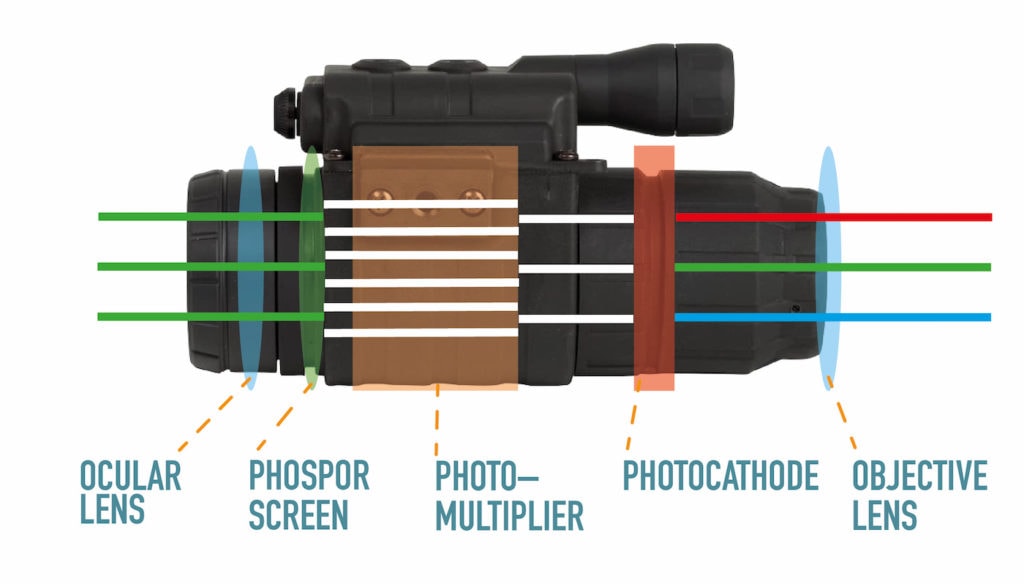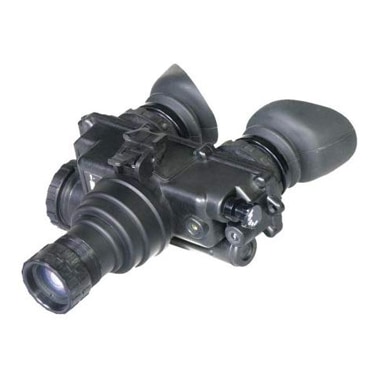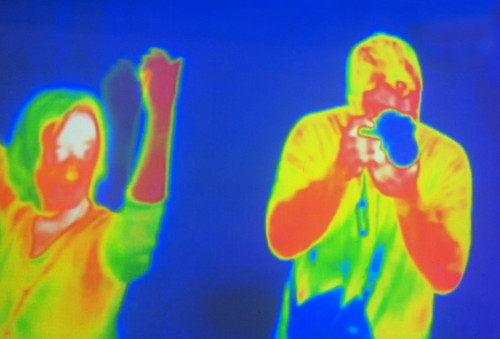How Do Night Vision Goggles Work?
Last Updated on

We have all seen those movies where the spec-ops soldier takes out a light source and then flips down his night vision goggles for a tactical advantage. While you might not be leading a ranger team into action, there’s no doubt about it — night vision goggles are pretty cool.
But just how do they work?
Without any visible light, night vision devices can help individuals see clearly in the dark for a number of different reasons. In this article, we’ll go over how night vision goggles gather “unseen” light, create usable imagery, the differences between night vision generation, and more!
It’s time to bring this topic to the light and find out exactly how night vision goggles work.
Understanding Electromagnetic Spectrum and Infrared Light
Before we can really explain how night vision goggles work, you need to have a basic understanding of the electromagnetic spectrum and the different forms of light found within, such as infrared light. That’s because night vision goggles can actually detect and use infrared.
But what exactly is infrared light?
Well, it turns out what light we can actually perceive is just a narrow slice of what is known as the electromagnetic spectrum. The electromagnetic spectrum is the entire range of different electromagnetic (EM) radiation that exists. And visible light is an EM wave that falls squarely in this range.

But there are many other forms of EM radiation and light that our eyes just cannot perceive on their own — such as infrared.
Do you remember the order in which a rainbow’s colors are set? It starts with red followed by orange, yellow, green, blue, and then violet. Well, it turns out that these colors are represented in that same order on the EM spectrum. And infrared literally means “before red”.
So, infrared light is light just below our eyes’ visible range. But just because we can detect infrared light with our own eyes doesn’t mean we can’t put infrared to use. That’s exactly where night vision goggles come into play.
How Do Night Vision Goggles Work?
Night vision goggles work on the premise of amplifying the infrared light and other faint visible light around your target to electronically produce a clear usable image. We want to be clear that some semblance of visible light must be present in order for night vision technology to work. But this can be moonlight, starlight, or other distantly produced light. There are only a few situations where you’ll have zero visible light to work with.
So, when a night vision device captures this faint and infrared light, it is directed to a photocathode. The photocathode is a very important part of the night vision assembly. It collects and converts the photons (light packets) into usable electrons.

After the electrons are created, they next head to the image intensifier tube — or IIT, a type of photo-multiplier. The IIT is what actually accelerates, amplifies, and converts the signal emitted from the electrons back into a usable image that you can see through the eyepiece.
Why is Night Vision Green?
So, what makes that trademark green output color? And why?
Well, when night vision imagery is originally produced, it’s only produced in black and white. There’s actually a special filter that your goggles will pass the light through in order to turn the image green.

Green is a very important color in terms of visible light. Remember the rainbow order from earlier? Green falls smack in the middle of our visible light spectrum making our eyes the most sensitive and receptive to that color. This means that we can look at green lighting for a longer period of time with minimal eye fatigue.
Gen2 Night Vision
Generation 2 night vision is another older form of night vision, but it hasn’t been phased out just yet. Gen2 improves upon Gen1 by introducing a microchannel plate to the night vision apparatus.

The microchannel plate is a direct improvement to the IIT. It’s a photosensitive plate that contains millions of independently working detecting and amplification channels. So instead of having a fewer number of channels working co-dependently and in unison, the addition of a microchannel plate helps to further your night vision goggles towards maximum efficiency.
Gen3 Night Vision
With Gen3 night vision, the biggest improvements come to the photocathode itself and the aforementioned microchannel plate.
The photocathode now has a specially engineered layer of gallium arsenide surrounding it. The crystalline structure of the chemical serves as a better semiconductor than on photocathodes without. This lets the photocathodes in night vision devices collect light signals more efficiently and transmit higher quality signals to the rest of the components.

On a Gen3 microchannel plate, an ion barrier film has been added. This film serves two purposes. First, it enhances the durability and lifespan of the device. And second, it reduces the electrical interference that will distort and otherwise alter your night vision device’s performance.
How is Night Vision Different from Thermal Imaging?
Another popular way of seeing images in the dark or other low light situations is through thermal imaging. And while these two serve a similar purpose, they operate on entirely different principles.

Night vision works by analyzing and converting faint and infrared light into usable images. However, thermal imaging is based on the natural heat emitted by people, objects, or others. These temperature differences are then collected and structured into a multi-colored heat map for you to see.
Related Read: 10 Best Thermal Vision Goggles: Reviews & Top Picks
Practical Uses of Night Vision Goggles
It’s not just military operators that can utilize night vision goggles. As a matter of fact, there are several different reasons why you may want to pick up a pair including:
- Hunting
- Nocturnal animal study
- Bird watchers searching for elusive night dwellers
- Private security surveillance
- Spelunking
- Driving at night
Should You Get Night Vision Goggles?
Although night vision goggles can be very useful, you need to consider if you actually need them. Despite recent advances in their tech, the cost for these devices is still very high when compared to other standard optics.
However, if you need a pair of night vision goggles, we recommend starting off with a pair from Gen2. They’re the most cost-efficient for civilian use and will basically cover everything you need them to.
Featured Image Credit: Tech. Sgt. Robert Cloys
About the Author Robert Sparks
Robert’s obsession with all things optical started early in life, when his optician father would bring home prototypes for Robert to play with. Nowadays, Robert is dedicated to helping others find the right optics for their needs. His hobbies include astronomy, astrophysics, and model building. Originally from Newark, NJ, he resides in Santa Fe, New Mexico, where the nighttime skies are filled with glittering stars.
Related Articles:
How to Clean a Refractor Telescope: Step-by-Step Guide
How to Clean a Telescope Eyepiece: Step-by-Step Guide
How to Clean a Rifle Scope: 8 Expert Tips
Monocular vs Telescope: Differences Explained (With Pictures)
What Is a Monocular Used For? 8 Common Functions
How to Clean a Telescope Mirror: 8 Expert Tips
Brightfield vs Phase Contrast Microscopy: The Differences Explained
SkyCamHD Drone Review: Pros, Cons, FAQ, & Verdict
